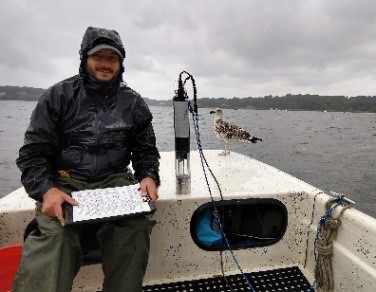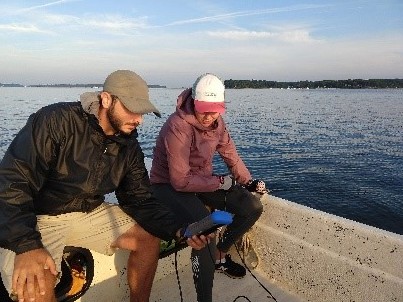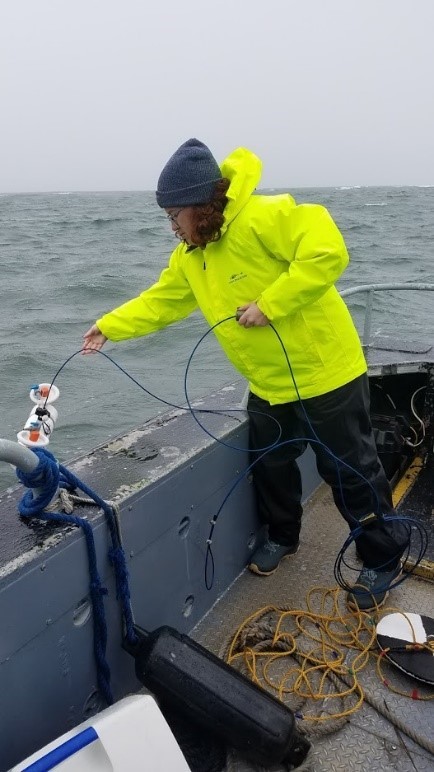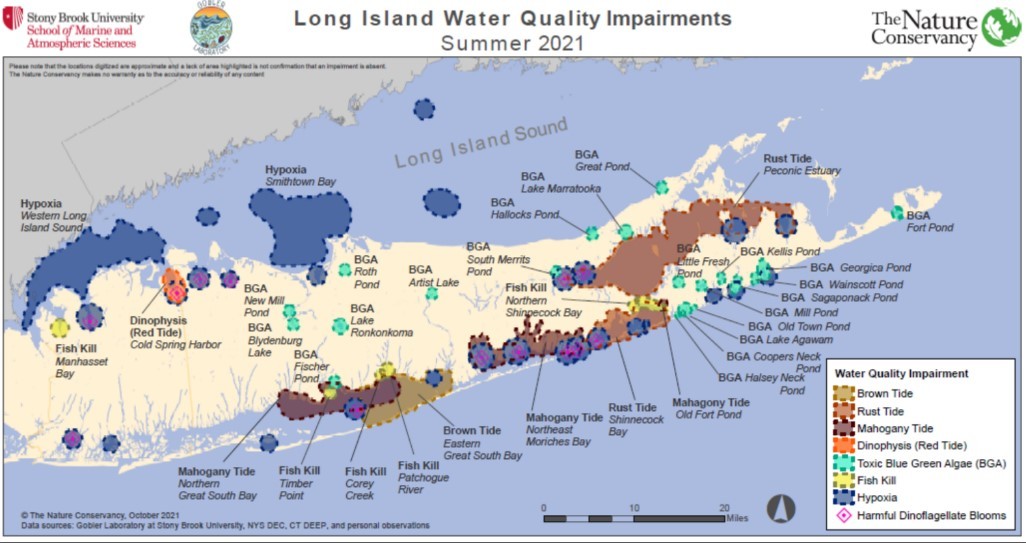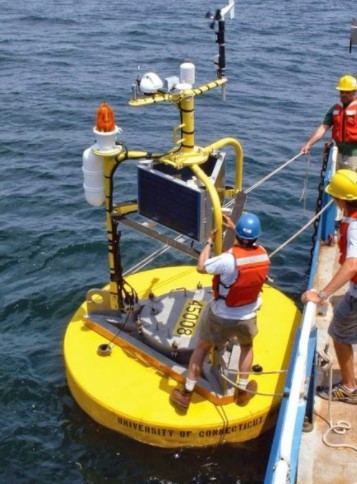Long Island Nitrogen Action Plan (LINAP) - Monthly Newsletter
The New York State Department of Environmental Conservation sent this bulletin on 11/29/2021 10:00 AM EST |
| DEC Delivers - Information to keep you connected and informed from the NYS Department of Environmental Conservation |
| Share or view as a web page || Update preferences or unsubscribe |
Long Island Nitrogen Action Plan (LINAP) - Monthly Newsletter
|
Save the Sound Unified Water StudyLaunched by Save the Sound in 2017, the Unified Water Study: Long Island Sound Embayment Research (UWS) is a water quality monitoring protocol designed to collect data and measure the health of the bays and harbors of the Long Island Sound (LIS). Save the Sound led the process to design and coordinate the study, working in collaboration with science advisors, other monitoring groups, and regulatory agencies including the United States Environmental Protection Agency, Connecticut Department of Energy and Environmental Protection (CTDEEP), NYS Department of Environmental Conservation (NYSDEC), and New York City Department of Environmental Protection (NYCDEP). Historically, monitoring work was conducted by different groups with different monitoring approaches making it difficult to accurately compare water quality conditions in the Sound’s many inlets. By standardizing the protocol, the UWS delivers more reliable data to further understanding of the health of the Sound which, in turn, will inform and support actions to preserve and protect it. The UWS measures the relative environmental health of the bays and harbors connected to the LIS to assess the human impact on them. It works with 23 volunteer groups to monitor 40 embayments and collects data from 413 monitoring stations across the LIS utilizing a coordinated schedule and uniform methodologies. It has two tiers of sampling that groups follow. Tier 1 monitoring looks at collecting baseline data and measures dissolved oxygen, water clarity, temperature, salinity, chlorophyll a, and qualitative macrophytes. Tier 2 includes Tier 1 parameters and additionally collects continuous dissolved oxygen, nitrogen, phosphorous, and quantitative macrophytes. The findings will further the understanding of the Sound and inform and support actions to preserve and protect it. To reach as many locations as possible, Save the Sound is training a wide variety of groups including volunteers, scientists, environmentalists and municipalities. If you are interested in participating, please contact the UWS Coordinator, Peter Linderoth, at plinderoth@savethesound.org.
UWS monitoring group in Northport-Huntington Bay. Photo Credits: Cornell Cooperative Extension of Suffolk County. Hempstead Bay Water Quality Monitoring ProgramNow in its third year, the Hempstead Bay Water Quality Monitoring Program provides a framework for monitoring, analysis, and reporting of water quality within the surface waters of Hempstead Bay (informally known as the Western Bays) and its major tributaries. The program, a collaboration among the Long Island Regional Planning Council (LIRPC), Hofstra University and the Town of Hempstead Department of Conservation and Waterways (TOH C&W), – continues to expand upon the monitoring that the Town of Hempstead conducted for nearly five decades in the south shore of Nassau County. The water quality data is being collected from strategic locations in Hempstead Bay which will provide baseline information against which to evaluate changes to nutrient loading. Over the next decade, there will be large-scale ecosystem-based and hard-engineered upgrades in the region (e.g., coastal dune restoration, wastewater treatment plant improvements, etc.). The data collected now will provide a way to measure the improvements from these major initiatives, which include the upgrades being completed at the South Shore Water Reclamation Facility that are expected to reduce wastewater treatment plant inputs to Hempstead Bay by 99 percent. The program also measures atmospheric nitrogen deposition which is associated with emissions from fossil fuel-related energy production, fertilizer usage, and transportation. This work is critical for quantifying the nitrogen input to Hempstead Bay and the surrounding watershed and will better inform nitrogen reduction targets. Nutrient (nitrate, ammonia, and orthophosphate) levels within the water were very high during the early decades of monitoring, particularly before 1990, but sampling done from the 2000’s to the present indicates continued improvement though concentrations are still high relative to natural systems. Bacteria (coliform counts) were very high from 1968 to the mid-1980s but have also shown a decline in recent decades. Atmospheric nitrogen deposition in dense suburban areas is higher than predicted by national monitoring sites, demonstrating the need for local measurements. There is a need to continue monitoring in Hempstead Bay; as inputs from wastewater treatment plants decline, other sources of nutrients will greatly increase in relative importance in Hempstead Bay such as atmospheric nitrogen deposition and fertilizer. The NYSDEC has approved funding for this program for an additional year.
Cassidy Freudenberg, TOH C&W employee, using the Van Dorn water sampler. Gobler LaboratoryGobler Laboratory, part of the School of Marine and Atmospheric Sciences (SoMAS) at Stony Brook University, assess water quality at 30 sites in Long Island’s estuaries and produces a water quality assessment based on their findings each October.
During the months of June through October 2021, every major bay and estuary across Long Island was afflicted by a toxic algae blooms and oxygen-starved, dead zones. Excessive delivery of nitrogen from onsite wastewater has been cited as the cause. The lab group has been monitoring and sampling Long Island’s waters on a weekly basis every summer since 2014. The data was reported on by News 12 and Newsday as part of their weekly Water Quality Index. SoMAS has also developed the Long Island Beach and Water Quality App (LIBAWQA), the world’s first all-in-one water quality app for the public. The LIBAWQA provides up to the minute information on the open and closed status of hundreds of Long Island regulated beaches, and the open and closed status of every bay, harbor, estuary, and river on Long Island with regard to shellfishing. In addition, the app features weekly water quality monitoring by the Gobler Laboratory which covers more than 30 locations across Long Island and provides information on algae, fecal coliform bacteria, dissolved, oxygen, water clarity, and harmful algal blooms like brown and red tides. While all of that data is available on the app, the app distills the detailed scientific information to a simple ranking of good, fair, or poor rating for each water body based on how conditions rank relative to state and federal water quality guidelines. Click here for instructions on how to access the Long Island Beach and Water Quality App. Long Island Sound Study Water Quality Monitoring ProgramsLong Island Sound Study Water Quality Monitoring Program:The Connecticut Department of Energy and Environmental Protection (CTDEEP), with funding provided by the Long Island Sound Study (LISS), has been conducting the Long Island Sound Water Quality Monitoring Program since 1991. Surface and bottom waters are monitored throughout New York and Connecticut embayments and open water. Testing parameters include water temperature, salinity, dissolved nitrogen, particulate nitrogen, water clarity, and dissolved oxygen. Data is used to identify annual trends and the general conditions of the Long Island Sound waters. Information about the program is on the CTDEEP website. Real-Time Monitoring on Long Island Sound Buoys:The Long Island Sound Integrated Coastal Observing System (LISICOS) was established in 2003. LISICOS is a water quality monitoring program that combines traditional ship-based point sampling surveys with continuous, real-time sampling stations. Sensors are attached to a moored buoy at various depths. Data are transmitted every 15 minutes in real-time via satellite where they are stored in a database and uploaded to the LISICOS website. The system is maintained by the University of Connecticut with support from LISS.
Deploying a monitoring buoy in the Western Sound. Photo credit: LISICOS. Water Quality Monitoring Programs in the Peconic EstuaryThis year the Peconic Estuary Partnership (PEP) finalized a Water Quality Monitoring Strategy. The Strategy includes a summary of existing water quality monitoring programs underway in the Peconic Estuary and an assessment of whether data collected by those programs can adequately track and detect changes in water quality needed to assess progress towards the goals identified in the 2020 Comprehensive Conservation and Management Plan (CCMP). To ensure effective implementation of the Strategy, PEP has developed a Peconic Estuary Water Quality Monitoring Collaborative (WQMC). The Collaborative is comprised of members of the NYSDEC, U.S. Geological Survey (USGS), Suffolk County, Cornell Cooperative Extension (CCE), and academic and non-profit groups. The WQMC utilized the data collected to evaluate water quality in the Estuary and produced the 2020 Annual Water Quality Report.
Water quality monitoring in the Estuary is conducted by various entities including the Suffolk County Department of Health Services, USGS, NYSDEC, CCE, SoMAS, Surf Rider Foundation and the National Atmospheric Deposition Program. A summary of each of these monitoring programs, including water type, sampling parameters, sampling frequency and monitoring stations can be found here. Water Quality Monitoring in the South Shore Estuary ReserveThe Long Island South Shore Estuary Reserve Coordinated Water Resources Monitoring Strategy (CWRMS), is a collaborative effort between the New York State Department of State and USGS. The Strategy is ongoing and will guide future monitoring efforts and help coordinate data on important challenges facing the Reserve, such as failing and outdated onsite wastewater treatment systems, declining fisheries and shellfish landings, wetland loss, and beach closures. Click here for the full CWRMS report that includes information on all the continuous water quality monitoring programs and the discrete water quality monitoring programs currently underway throughout the Reserve. The CWRMS interactive mapper can be found here. There is a comprehensive water quality monitoring network in place throughout the Reserve conducted by entities such as Town of Hempstead, USGS, LIshore, SCDHS, Center for Environmental Research and Coastal Oceans Monitoring, New York State Office of Parks, Recreation, and Historical Preservation, Nassau County Department of Health, National Oceanic and Atmospheric Administration, Operation SPLASH and a collaboration between NYSDEC, NYS Department of State, Sea Grant and SoMAS. Information on all of these programs can be found here. To sign up for our LINAP Newsletter, visit our LINAP webpage or click here. Want to share this newsletter on your social media? Click the share button to connect to your Facebook, Twitter, LinkedIn, or email and let your followers know about what is happening with LINAP! |

